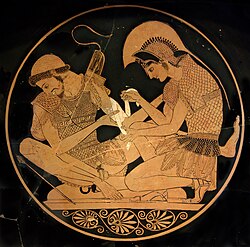
| Trojan War |
|---|
 |
The Trojan Battle Order or Trojan Catalogue is an epic catalogue in the second book of the Iliad [1] listing the allied contingents that fought for Troy in the Trojan War. The catalogue is noted for its deficit of detail compared to the immediately preceding Catalogue of Ships, which lists the Greek contingents, and for the fact that only a few of the many Trojans mentioned in the Iliad appear there.